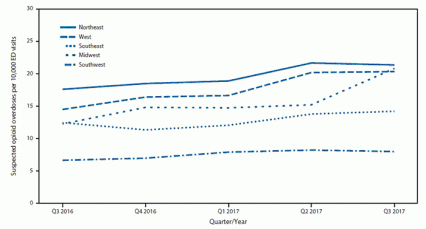中国公安部官员:芬太尼危机根源是美国
10/12/2021
中国公安部禁毒情报技术中心副处长花镇东在接受采访时指出,世界各国都存在阿片类物质滥用问题,但普遍使用的都是海洛因,仅有美国存在严重的以芬太尼类物质为代表的合成阿片类物质滥用和致死情况。“造成这一问题的根源完全在美国自身,美国阿片危机的源头是处方药滥用问题。”
据环球网报道,花镇东介绍,在上世纪90年代中后期,以普渡制药公司为代表的美国大型药企推出了以羟考酮、氢可酮等半合成阿片类药物为主要成分的止痛药。该类药物止痛效果更好,同时成瘾性和健康危害也大大增加,它们本应在严格监管下使用,但药企为了增加销量,通过大量公关和营销等手段说服监管机构放松管制政策,并诱导医生开出该类药物的处方。
花镇东说,在这种背景下,普通人群即使没有任何健康问题,只要向医生叙述有伤痛就可以获得阿片类药物,由此导致该类药物在美国的使用呈几何倍数增长。2009年美国全国药物滥用调查显示,美国新增吸毒人员中约1/3由滥用处方药开始,滥用的品种主要是羟考酮、氢可酮等半合成阿片类药物,由此导致的死亡案例激增。
他指出,近年来美国药物滥用问题日趋严峻复杂,吸毒过量致死人数逐年上升,已超过了枪击和车祸的死亡人数,由此导致美国人均预期寿命连续两年出现下降。其中阿片类物质由于危险性极高,是滥用致死的主要原因,约2/3的死亡案例与此有关。
美国政府于2011年发布应对处方药滥用问题的白皮书,重新加强阿片类药物的管制,但经过十余年的市场培养,美国已经形成了庞大的阿片类物质成瘾群体,在处方药获得难度加大的情况下,不少滥用者开始将目标转向更为危险的地下加工厂非法生产的阿片类物质。
花镇东指出,除此之外,美国政府对贩毒集团打击不力也导致非法生产的阿片类物质得以在美国泛滥。在世界范围内,滥用最为广泛的非法生产阿片类物质是海洛因。而某国贩毒集团生产的海洛因在美国的市场占有率逐步上升至90%以上。但该国生产的海洛因质量较差,难以满足滥用者的需求。
花镇东介绍说,在此背景下,贩毒集团盯上了效果较强且不依赖于罂粟种植,直接通过化学合成即可生产的芬太尼类物质。他们一方面在低品质海洛因中掺杂芬太尼提高药效,甚至只用芬太尼掺杂其他物质后冒充海洛因出售;另一方面还将芬太尼类物质制成外观类似合法药企生产的羟考酮和氢可酮片剂,向习惯使用处方药的滥用群体出售。
他说,由于贩毒集团生产毒品时品控不严格,其产品中芬太尼类物质的含量差异较大,一旦滥用者购买到含量超过安全限量的毒品,吸食后极易导致死亡。
花镇东表示,“如果美国不能解决其存在的大规模阿片类物质成瘾群体,不能解决某国贩毒集团操控下的制贩毒网络,那么美国庞大的非法阿片类物质需求将一直存在,芬太尼类物质滥用问题永远也难以解决。美国只有正视自身问题,从内因着手,尽量减少国内的阿片类物质需求,才能真正解决芬太尼类物质滥用问题。”
Opioid Overdose Crisis
10/12/2021
In 2019, nearly 50,000 people in the United States died from opioid-involved overdoses.1 The misuse of and addiction to opioids—including prescription pain relievers, heroin, and synthetic opioids such as fentanyl—is a serious national crisis that affects public health as well as social and economic welfare. The Centers for Disease Control and Prevention estimates that the total “economic burden” of prescription opioid misuse alone in the United States is $78.5 billion a year, including the costs of healthcare, lost productivity, addiction treatment, and criminal justice involvement.2
How did this happen?
In the late 1990s, pharmaceutical companies reassured the medical community that patients would not become addicted to prescription opioid pain relievers, and healthcare providers began to prescribe them at greater rates. This subsequently led to widespread diversion and misuse of these medications before it became clear that these medications could indeed be highly addictive.3,4 Opioid overdose rates began to increase. In 2017, more than 47,000 Americans died as a result of an opioid overdose, including prescription opioids, heroin, and illicitly manufactured fentanyl, a powerful synthetic opioid.1 That same year, an estimated 1.7 million people in the United States suffered from substance use disorders related to prescription opioid pain relievers, and 652,000 suffered from a heroin use disorder (not mutually exclusive).5
What do we know about the opioid crisis?
- Roughly 21 to 29 percent of patients prescribed opioids for chronic pain misuse them.6
- Between 8 and 12 percent of people using an opioid for chronic pain develop an opioid use disorder.6
- An estimated 4 to 6 percent who misuse prescription opioids transition to heroin.7–9
- About 80 percent of people who use heroin first misused prescription opioids.7
- Update: Among 38 states with prescription opioid overdose death data, 17 states saw a decline between 2017-2018; none experienced a significant increase.11
- Likelihood of developing an opioid use disorder depends on many factors, including length of time a person is prescribed to take opioids for acute pain, and length of time that people continue taking opioids (whether as prescribed, or misused).
Image

Source: Centers for Disease Control and Prevention. (10)
This issue has become a public health crisis with devastating consequences including increases in opioid misuse and related overdoses, as well as the rising incidence of neonatal abstinence syndrome due to opioid use and misuse during pregnancy. The increase in injection drug use has also contributed to the spread of infectious diseases including HIV and hepatitis C. As seen throughout the history of medicine, science can be an important part of the solution in resolving such a public health crisis.
What are HHS and NIH doing about it?
In response to the opioid crisis, the U.S. Department of Health and Human Services (HHS) is focusing its efforts on five major priorities:
- improving access to treatment and recovery services
- promoting use of overdose-reversing drugs
- strengthening our understanding of the epidemic through better public health surveillance
- providing support for cutting-edge research on pain and addiction
- advancing better practices for pain management
The National Institutes of Health (NIH), a component of HHS, is the nation’s leading medical research agency helping solve the opioid crisis via discovering new and better ways to prevent opioid misuse, treat opioid use disorders, and manage pain. In the summer of 2017, NIH met with pharmaceutical companies and academic research centers to discuss:
- safe, effective, non-addictive strategies to manage chronic pain
- new, innovative medications and technologies to treat opioid use disorders
- improved overdose prevention and reversal interventions to save lives and support recovery
In April 2018 at the National Rx Drug Abuse and Heroin Summit, NIH Director Francis S. Collins, M.D., Ph.D., announced the launch of the HEAL (Helping to End Addiction Long-term) Initiative, an aggressive, trans-agency effort to speed scientific solutions to stem the national opioid public health crisis.
- CDC/NCHS, National Vital Statistics System, Mortality. CDC WONDER, Atlanta, GA: US Department of Health and Human Services, CDC; 2019. https://wonder.cdc.gov.
- Florence CS, Zhou C, Luo F, Xu L. The Economic Burden of Prescription Opioid Overdose, Abuse, and Dependence in the United States, 2013. Med Care. 2016;54(10):901-906. doi:10.1097/MLR.0000000000000625.
- Morone NE, Weiner DK. Pain as the fifth vital sign: exposing the vital need for pain education. Clin Ther. 2013;35(11):1728-1732. doi:10.1016/j.clinthera.2013.10.001.
- Van Zee A. The Promotion and Marketing of OxyContin: Commercial Triumph, Public Health Tragedy. Am J Public Health. 2009;99(2):221-227. doi:10.2105/AJPH.2007.131714.
- Center for Behavioral Health Statistics and Quality (CBHSQ). 2017 National Survey on Drug Use and Health: Detailed Tables. Rockville, MD: Substance Abuse and Mental Health Services Administration; 2018.
- Vowles KE, McEntee ML, Julnes PS, Frohe T, Ney JP, van der Goes DN. Rates of opioid misuse, abuse, and addiction in chronic pain: a systematic review and data synthesis. Pain. 2015;156(4):569-576. doi:10.1097/01.j.pain.0000460357.01998.f1.
- Muhuri PK, Gfroerer JC, Davies MC. Associations of Nonmedical Pain Reliever Use and Initiation of Heroin Use in the United States. CBHSQ Data Rev. August 2013.
- Cicero TJ, Ellis MS, Surratt HL, Kurtz SP. The Changing Face of Heroin Use in the United States: A Retrospective Analysis of the Past 50 Years. JAMA Psychiatry. 2014;71(7):821-826. doi:10.1001/jamapsychiatry.2014.366.
- Carlson RG, Nahhas RW, Martins SS, Daniulaityte R. Predictors of transition to heroin use among initially non-opioid dependent illicit pharmaceutical opioid users: A natural history study. Drug Alcohol Depend. 2016;160:127-134. doi:10.1016/j.drugalcdep.2015.12.026.
- Vivolo-Kantor, AM, Seth, P, Gladden, RM, et al. Vital Signs: Trends in Emergency Department Visits for Suspected Opioid Overdoses–United States, July 2016-September 2017. Centers for Disease Control and Prevention
- Wilson N, Kariisa M, Seth P, Smith H IV, Davis NL. Drug and Opioid-Involved Overdose Deaths — United States, 2017–2018. MMWR Morb Mortal Wkly Rep 2020;69:290–297. DOI: http://dx.doi.org/10.15585/mmwr.mm6911a4
诚招美国和加拿大法律服务代理
因公司发展需要,诚招美国和加拿大法律服务代理。
要求:
懂英语、或西班牙语、或法语。
能合法工作有社安号或工号。
无需改行, 可以兼职。
大学生和有销售经验优先考虑。
自雇生意公司发美国报税1099,加拿大T4A
有意了解详情, 请扫码加微信, 非诚勿扰!




